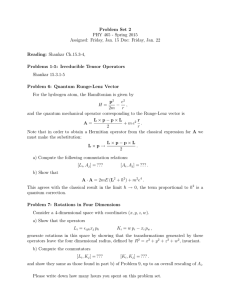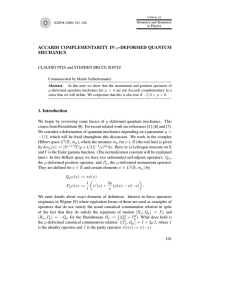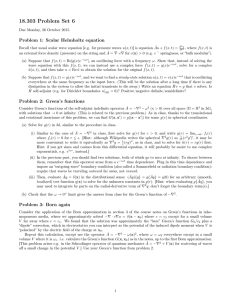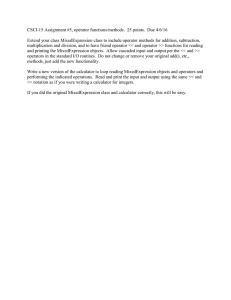PX430: Gauge Theories for Particle Physics Tim Gershon ()
advertisement
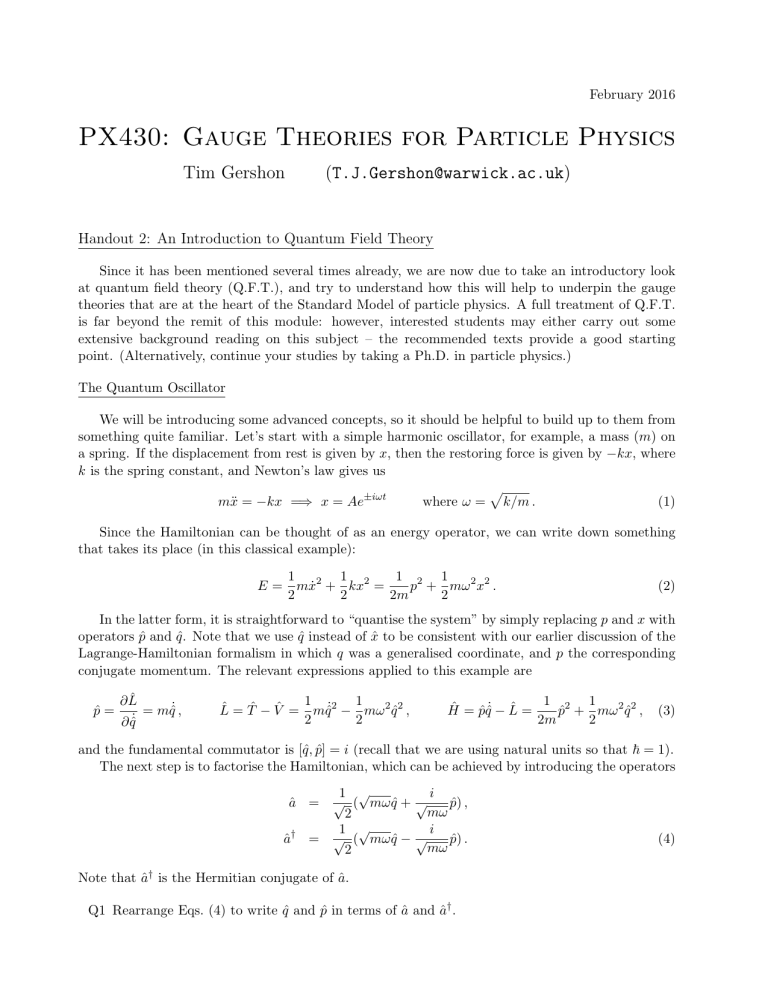
February 2016 PX430: Gauge Theories for Particle Physics Tim Gershon (T.J.Gershon@warwick.ac.uk) Handout 2: An Introduction to Quantum Field Theory Since it has been mentioned several times already, we are now due to take an introductory look at quantum field theory (Q.F.T.), and try to understand how this will help to underpin the gauge theories that are at the heart of the Standard Model of particle physics. A full treatment of Q.F.T. is far beyond the remit of this module: however, interested students may either carry out some extensive background reading on this subject – the recommended texts provide a good starting point. (Alternatively, continue your studies by taking a Ph.D. in particle physics.) The Quantum Oscillator We will be introducing some advanced concepts, so it should be helpful to build up to them from something quite familiar. Let’s start with a simple harmonic oscillator, for example, a mass (m) on a spring. If the displacement from rest is given by x, then the restoring force is given by −kx, where k is the spring constant, and Newton’s law gives us p mẍ = −kx =⇒ x = Ae±iωt where ω = k/m . (1) Since the Hamiltonian can be thought of as an energy operator, we can write down something that takes its place (in this classical example): 1 1 1 2 1 E = mẋ2 + kx2 = p + mω 2 x2 . 2 2 2m 2 (2) In the latter form, it is straightforward to “quantise the system” by simply replacing p and x with operators p̂ and q̂. Note that we use q̂ instead of x̂ to be consistent with our earlier discussion of the Lagrange-Hamiltonian formalism in which q was a generalised coordinate, and p the corresponding conjugate momentum. The relevant expressions applied to this example are p̂ = ∂ L̂ = mq̂˙ , ∂ q̂˙ 1 1 L̂ = T̂ − V̂ = mq̂˙2 − mω 2 q̂ 2 , 2 2 1 2 1 Ĥ = p̂q̂˙ − L̂ = p̂ + mω 2 q̂ 2 , 2m 2 (3) and the fundamental commutator is [q̂, p̂] = i (recall that we are using natural units so that ~ = 1). The next step is to factorise the Hamiltonian, which can be achieved by introducing the operators â = ↠= 1 √ i √ ( mω q̂ + √ p̂) , mω 2 1 √ i √ ( mω q̂ − √ p̂) . mω 2 Note that ↠is the Hermitian conjugate of â. Q1 Rearrange Eqs. (4) to write q̂ and p̂ in terms of â and ↠. (4) Using Eqs. (4) we can show that 1 1 2 mω q̂ 2 + p̂ + 2 2mω 1 1 2 mω q̂ 2 + p̂ − 2 2mω â↠= ↠â = i [p̂, q̂] , 2 i [p̂, q̂] , 2 (5) and hence [â, ↠] = i[p̂, q̂] = 1 . (6) Q2 Using Eqs. (4), explicitly derive Eqs. (5) and (6). We can then show that 1 1 Ĥ = (↠â + â↠)ω = (↠â + )ω , 2 2 (7) and [Ĥ, â] = −ωâ & [Ĥ, ↠] = ω↠. (8) Q3 Explicitly derive Eqs. (7) and (8). Let us now consider an eigenstate of Ĥ, with energy eigenvalue En . Denoting this state by |ni, this means that Ĥ|ni = En |ni. Using Eqs. (8), it is easy (so easy that we won’t even bother with a question to show it explicitly, but don’t let that stop you if you feel the urge) to show that Ĥ(↠|ni) = (En + ω)(↠|ni) , Ĥ(â|ni) = (En − ω)(â|ni) , (9) i.e. that ↠raises the energy by one quanta (ω), while â lowers the energy by one quanta (recall again that ~ = 1). Since the energy of the system in this example is positive definite, we cannot just keep on repeatedly applying the â operator to get lower and lower energies. That is, there must be some lowest energy state |0i, such that â|0i = 0. This state has energy ω/2, since 1 1 Ĥ|0i = (↠â + )ω|0i = 0 + ω|0i , 2 2 (10) i.e. there is zero point energy. Having found the lowest energy state, we can find all other states by repeated application of the raising operator ↠, e.g. |1i = ↠|0i where 1 Ĥ|1i = (1 + )ω|1i . 2 (11) After n applications of ↠, we reach the state |ni, which has energy (n + 1/2)ω, i.e. 1 1 Ĥ|ni = (↠â + )ω|ni = (n + )ω|ni , 2 2 (12) from which we can identify the number operator n̂ = ↠â, leading to the delightfully confusing equation n̂|ni = n|ni (13) (each of n̂, |ni and n has a different meaning – they are operator, state and number respectively). Q4 Choosing a normalisation such that hn|ni = 1, show that the state |ni is given by 1 |ni = √ (↠)n |0i . n! (14) n.b. It will help to know that, e.g. (↠|0i)† = h0|â. Q5 What is [Ĥ, n̂]? What is the physical meaning of this result? Multiple Quantum Oscillators Let us turn our consideration to a system with N independent oscillators. Since these are independent, we can just add the Lagrangians to find L̂ = N X L̂r = r=1 N X 1 r=1 1 mq̂˙r2 − mωr2 q̂r2 2 2 , (15) where we have allowed each oscillator to have a different frequency ωr . (The masses of each oscillator have been constrained to be the same, but since the mass appears only linearly this does not reduce the generality of the system. If we imagine two oscillators with different masses which, for convenience, we write as different multiples of some base mass m, i.e. M1 = N1 m and M2 = N2 m, we would be able to rewrite the Lagrangian in terms of the base mass m, in the form of Eq. (15).) The basic commutation relations in this case are [q̂r , p̂s ] = iδrs , [q̂r , q̂s ] = [p̂r , p̂s ] = 0 . (16) Then we can show that in this system N X 1 2 1 2 2 Ĥ = p̂ + mωr q̂r , 2m r 2 = = r=1 N X 1 (â†r âr + )ωr , 2 r=1 N X r=1 1 (n̂r + )ωr , 2 (17) with (hopefully) obvious definitions of â†r , âr and n̂r that follow from the previous discussion. Q6 Satisfy yourself of the derivation of Eqs. (17). What are the various commutation relations between â†r , âr , n̂r and Ĥ? P Q7 Defining the total number operator n̂tot = N r=1 n̂r , what are the commutation relations be† tween n̂tot and âr , âr , n̂r and Ĥ? Q8 What is the zero point energy of this system? The above discussion is for independent oscillators, but we might reasonably be more interested in the case of coupled oscillators. However, as should be familiar from the classical case, we can decompose a system of N coupled oscillators into normal modes, which behave as independent oscillators. In the limit N → ∞, the decomposition becomes a Fourier transform. So the above discussion remains applicable also for the coupled case. Q9 Refresh your memory of classical coupled oscillators, and satisfy yourself with the above arguments. P To summarise the case of multiple oscillators, the eigenstates of Ĥ have energies N r=1 (nr + 1)ωr , and can be written as products of individual oscillator eigenstates: |n1 i|n2 i . . . |nN i = |n1 , n2 , . . . nN i. The ground state |0, 0, . . . 0i ≡ |0i, where âr |0i = 0 ∀ r. Finally, remember the operators â†r create oscillator quanta , the operators âr destroy oscillator quanta . Second Quantisation It is (finally) time to move from many discrete oscillators, to a continuous field. Since the field will now be quantised, we are entering quantum field theory territory. The quantisation of the field is sometimes called second quantisation, where first quantisation was the quantisation of the canonical coordinates and momenta (note that – despite the name – nothing gets quantised twice). We can summarise the change from discrete to continuous as qr (t) → φ(x, t) q̂r (t) → φ̂(x, t) (classical) (quantum) pr (t) → Π(x, t) p̂r (t) → Π̂(x, t) where φ and φ̂ are the field density and field density operator respectively, and Π and Π̂ are the momentum density and momentum density operator respectively. [We will at times be casual with vocabulary, and drop either or both of “density” and “operator” when discussing these quantities. Note also that we use Π to avoid possible confusion with the number π, which will appear in our ˙ equations later.] For the purposes of the Lagrange-Hamiltonian formalism, we can define Π̂ = ∂ L̂/∂ φ̂, ˙ where L̂ is the Lagrangian density operator; the Hamiltonian density operator is given by Ĥ = Π̂φ̂− L̂. The Euler-Lagrange equations can be written ! ∂ L̂ ∂ L̂ − ∂µ = 0. (18) ∂ φ̂ ∂(∂µ φ̂) Finally, we will certainly need the all important commutation relation [φ̂(x, t), Π̂(x0 , t)] = iδ(x − x0 ) , (19) [φ̂(x, t), φ̂(x0 , t)] = [Π̂(x, t), Π̂(x0 , t)] = 0 . (20) and we also have n.b. technically, these should be referred to as equal time commutation relations. Clearly we do not have spatial and temporal coordinates on the same footing, thus failing our basic criterion for relativistic invariance. We will see how this develops below. A One-Dimensional Quantum Field All of the above is with only one spatial dimension (though the extension to three dimensions is simple, as we shall see). To try to visualise what is happening, it may help to think of the system as a string, with mass per unit length ρ, and displacement φ as a function of distance along the string x, and time t. The Lagrangian for this system (not quantised yet) is 1 L=T −V = ρ 2 ∂φ ∂t 2 1 − ρc2 2 ∂φ ∂x 2 , (21) where T and V are kinetic and potential energy terms, respectively, and c is the speed of waves along the string. In this case we find Π = ∂L/∂ φ̇ = ρφ̇, and 1 2 1 2 ∂φ 2 H= Π + ρc . (22) 2ρ 2 ∂x In what follows we will set ρ = c = 1 for convenience. We can second quantise the above system to find !2 !2 !2 1 ∂ φ̂ ∂ L̂ 1 ∂ φ̂ 1 2 1 ∂ φ̂ ˙ L̂ = T̂ − V̂ = − , Π̂ = . (23) = φ̂ , Ĥ = Π̂ + ˙ 2 ∂t 2 ∂x 2 2 ∂x ∂ φ̂ Noting that φ̂ and Π̂ are Hermitian operators, since they are real valued in this case (since they correspond to observable quantities – recall the visualisation of the system as a string), we can write these in terms of Fourier transformations: Z +∞ h i dk φ̂(x, t) = â(k)eikx−iωt + ↠(k)e−ikx+iωt , −∞ (2π)(2ω) Z +∞ h i dk Π̂(x, t) = (−iω) â(k)eikx−iωt − ↠(k)e−ikx+iωt . (24) −∞ (2π)(2ω) In this case, ↠= â∗ (â and ↠are not Hermitian). Note that ω = ω(k), though this dependence has not been written explicitly. Q10 Refresh your memory of the definition of a Hermitian operator. ˙ Q11 Show that Eqs. (24) are consistent with Π̂ = ∂ L̂/∂ φ̂. Q12 Using the fundamental commutator from Eq. (19), show that [â(k), ↠(k 0 )] = (2π)(2ω)δ(k − k 0 ) and [â(k), â(k 0 )] = [↠(k), ↠(k 0 )] = 0. You will need to use the Fourier transform of Eq. (24), and be sure to use different (dummy) variables for the two integrals, e.g. k and k 0 . Using these relations we can show that Z +∞ Z +∞ dxĤ = Ĥ = −∞ Z +∞ = −∞ −∞ dk (2π)(2ω) 1 1 dx Π̂2 + 2 2 ∂ φ̂ ∂x !2 , 1 † † â (k)â(k) + â(k)â (k) ω . 2 (25) Noting again that ↠= â∗ in this case, we can see that Eq. (25) corresponds to an integral of the density of states (1/2ω(k) – see below) times by the energy per mode |â|2 ω(k). Q13 Prove Eq. (25). You will need to use the Fourier transform of Eq. (24), and when calculating terms such as Π̂2 , multiply integrals over different (dummy) variables, e.g. k and k 0 . Q14 Find expressions for [Ĥ, â(k)] and [Ĥ, ↠(k)], and satisfy yourself that ↠(k) and â(k) are creation and annihilation operators of quanta of mode k, respectively. Using the commutation relations of the â and ↠operators, we can subsequently show that Z +∞ Z +∞ dk 1 dk † Ĥ = â (k)â(k)ω + [â(k), ↠(k)]ω −∞ (2π)(2ω) −∞ (2π)(2ω) 2 Z +∞ Z +∞ dk 1 = ↠(k)â(k)ω + dk δ(0)ω . (26) (2π)(2ω) 2 −∞ −∞ The second term deserves some comment. Clearly, it is the quantum field zero point energy, yet it is infinite. In the more physical three-dimensional case, the infinity remains. The R +∞δ(0) term looks most worrisome, but in fact this part is not a particular problem – we can write −∞ dx exp(ik.x) = (2π)δ(k), which for k = 0 corresponds to the length (or, in the three-dimensional case, the volume) of space. But an infinity remains in the Hamiltonian density, as we are integrating over the energy in each mode ω. The standard treatment is to claim that only differences in energy are observable, and that as long as the infinity appears everywhere it can be neglected. This is a good way to proceed quickly, so we will follow it. However, it is worthwhile to briefly note that the problem arises due to the integral extending to very large wavenumber k, which corresponds to very high energies, or very small distance scales. In fact, we know that physics at such scales is not well understood, and we expect that the theories being discussed in this module are only a “low energy” approximation of a more fundamental theory, that will hopefully take gravity, for example, into account. One possible direction for such a theory of “quantum gravity” is string theory, which addresses the problem of short distance scales by replacing point like objects with vibrations of “strings”, which are extended in (at least) one dimension. Clearly (and thankfully), this is a long way beyond the scope of this module, and for now we content ourselves to ignore the zero point energy term, in the expectation that it will be addressed by a deeper, yet-to-be discovered, theory. With this treatment, we now have Z +∞ Z +∞ dk dk † Ĥ = â (k)â(k)ω = n̂(k)ω (27) −∞ (2π)(2ω) −∞ (2π)(2ω) where n̂(k) = ↠(k)â(k) is the number operator for mode k, analogous to the previous case. This form of Ĥ is sometimes referred to as a normal ordered form (and is sometimes denoted : Ĥ :), which means that the â(k) operators appear on the right. Note that : Ĥ : is still Hermitian. Since â(k)|0i = 0, we find that :Ĥ: |0i = 0 – not surprising since we have suppressed the zero point energy. Q15 What is [Ĥ, n̂(k)]? What is [:Ĥ:, n̂(k)]? Q16 Defining the total number operator n̂tot = R +∞ dk −∞ (2π)(2ω) n̂(k), what is [Ĥ, n̂tot ]? Let us conclude this section with some further comments. • Quanta of excitation of the field φ̂ are particles, e.g. photons for the electromagnetic case. • The operators â(k) and ↠(k) that appear in the Fourier decomposition of the quantum field φ̂ have a simple interpretation: ↠(k) creates quanta of k mode â(k) destroys quanta of k mode . Since we are aiming to develop a theory that can handle creation and annihilation of particles and antiparticles, the appearance of these operators might make us optimistic that we are on the right track. • Since our field operator φ̂ is Hermitian, it corresponds to a particle that is its own antiparticle (particles that are distinct from their antiparticles will be discussed later). • There is a state |0i such that â(k)|0i = 0 ∀k, i.e. it is the vacuum. • There is an infinite zero point energy associated with quantum fluctuations of the vacuum, and we conventionally discard this term. • Nonetheless, vacuum fluctuations cause observable effects, such as the Casimir effect: an attractive force observed when two large conducting plates are placed close to each other, such that the boundary conditions remove low frequency modes and reduce the vacuum energy. • We can create an arbitrary multiparticle state from the vacuum by repeated application of ↠(k) operators: |k1 , k2 , . . .i = ↠(k1 )↠(k2 ) . . . |0i. • Since any two ↠(k) operators commute, we can write (for an arbitrary two particle state) |k1 , k2 i = ↠(k1 )↠(k2 )|0i = ↠(k2 )↠(k1 )|0i = |k2 , k1 i, i.e. the system is symmetric under the interchange of particles labelled by k1 and k2 – they are bosons, and obey Bose-Einstein statistics. • The field operator interpretation of quantum field theory can be related to the wavefunction interpretation of regular quantum mechanics by noting that h0|φ̂|ki = h0|φ̂↠(k)|0i = eikx−iωt . Q17 Using the Fourier expansion for φ̂, and the commutation relations for â(k) and ↠(k), show that h0|φ̂|ki = h0|φ̂↠(k)|0i = eikx−iωt . Three-Dimensional Quantum Fields The more physical three-dimensional case is obtained as a fairly straightforward extension of the above discussion. In this case Z +∞ i h d3 k ik.x−iωt † −ik.x+iωt , φ̂(x, t) = â(k)e + â (k)e 3 −∞ (2π) (2ω) Z +∞ h i d3 k ik.x−iωt † −ik.x+iωt Π̂(x, t) = (−iω) â(k)e − â (k)e , (28) 3 −∞ (2π) (2ω) where, again, the dependence of ω = ω(k) on k has not been made explicit. The fundamental commutator is now [φ̂(x, t), Π̂(x0 , t)] = iδ 3 (x − x0 ) , (29) where δ 3 is the three-dimensional delta function (this is still an equal time commutation relation). These expressions then give the commutation relations between â(k) and ↠(k) operators [â(k), ↠(k0 )] = (2π)3 (2ω) δ 3 (k − k0 ) , and any two â(k) operators commute, as do any two ↠(k0 ) operators. The Hamiltonian is now Z +∞ Ĥ = d3 xĤ , −∞ Z +∞ 1 † d3 k † = â (k)â(k) + â(k)â (k) ω , 3 2 −∞ (2π) (2ω) (30) (31) which again can be interpreted as an integral of the density of states times by the energy per mode. The normal ordered form is Z +∞ d3 k ↠(k)â(k)ω . (32) :Ĥ: = 3 (2ω) (2π) −∞ It is worth noting that the normalisation we have used is such that there are 2ω (or 2E) particles per unit volume (recall the discussion concerning the normalisation of Dirac spinors in PX408). This is a convenient method to make our operators Lorentz invariant – if the normalisation was to one particle per unit volume they would not be Lorentz invariant since the volume element is contracted (by the Lorentz factor γ) when transforming to another frame. The appropriate Lorentz invariant phase space element is d3 k/2ω. Finally, recall that we do not expect the Hamiltonian to be Lorentz invariant (since it gives the energy, which is the time-like component of a four-vector). Q18 By considering hk|ki, show that our choice of normalisation is such that there are 2E particles per unit volume. Q19 Show that the phase space element d3 k/2ω is Lorentz invariant. n.b. recall that ω = ω(k). Finally, note that this introduction to QFT follows fairly closely Chapter 5 of Aitchison & Hey edition, Volume I), which would be a good starting point for further reading. (3rd
